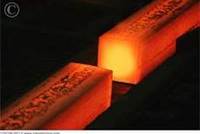U. S. Steel CEO: New Steel Grades Will Play Leading Role In Achieving Future Fuel Economy Requirements
 |
Multi-million dollar project to drive the third generation of advanced steel grades
DETROIT--April 11, 2013: What material will lead the way in helping automakers achieve future fuel economy requirements? According to John Surma, chairman and CEO of United States Steel Corporation, the clear answer is steel. During an Automotive Press Association Luncheon held today at the Detroit Athletic Club, Surma discussed how new steel grades will play a critical role in evolving automotive designs to meet the 2025 54.5 mpg mandate.
During the event hosted by the Steel Market Development Institute (SMDI), a business unit of the American Iron and Steel Institute (AISI), Surma outlined why advanced high-strength steels (AHSS) are the fastest growing materials in vehicles and will continue to grow. According to Surma, steel's continued growth and development is due to its wide range of properties that allow it to satisfy increasing vehicle safety and performance requirements while generating significantly lower greenhouse gas emissions compared to other materials, all at a competitive cost.
Surma cited multiple examples to support steel's "complete package" message, including the successful FutureSteelVehicle program that demonstrates how new steels and design methods can reduce body-in-white mass by 39 percent compared to traditional steel bodies, while also reducing life cycle emissions by nearly 70 percent without a cost increase. He also cited a project in which a front lower control arm made from an alternative material was replaced with an AHSS part of the same weight at 30 percent lower cost.
"The combinations of scientific research and product development have brought our industry to this point in the development of new steels," Surma said. "Now, as an industry, we are continuing our research on the next -- the third -- generation of advanced high-strength steels."
During his presentation, Surma discussed an aggressive collaborative project to help create the next generation of advanced steel grades. SMDI together with the Auto/Steel Partnership and the U.S. Automotive Materials Partnership received an award of $6 million from the U.S. Department of Energy for its "Integrated Computational Materials Engineering Approach to Development of Lightweight, Third-Generation Advanced High-Strength Steels" project. The four-year project began in the first quarter of 2013 and will develop integrated computer models to accelerate the development of the next generation of weight-saving high-strength products. Along with steel companies and car companies, five universities, two engineering companies and Pacific Northwest National Laboratory will participate in the research.
"The program will start from atomic and nano scale models of steel and continue through the performance of these steels in actual vehicles," Surma said. "Establishing such intelligent systems for new steel development will be a powerful tool to help our industry design the steels of tomorrow."
For additional information about the steel industry's efforts to develop the next generation of automotive steel or the material's complete package benefit, please visit AutoSteel .
AISI serves as the voice of the North American steel industry in the public policy arena and advances the case for steel in the marketplace as the preferred material of choice. AISI also plays a lead role in the development and application of new steels and steelmaking technology. AISI is comprised of 25 member companies, including integrated and electric furnace steelmakers, and 125 associate members who are suppliers to or customers of the steel industry. AISI's member companies represent over three quarters of both U.S. and North American steel capacity.


